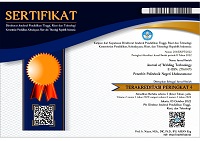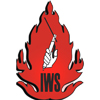Hardness Analysis of Aluminium 5083 A-TIG Welding Due to The Effect of Active Flux and Current
Abstract
Keywords
Full Text:
PDFReferences
S. S. Mirjavadi et al., “Influence of TiO2 nanoparticles incorporation to friction stir welded 5083 aluminum alloy on the microstructure, mechanical properties and wear resistance,” J. Alloys Compd., vol. 712, pp. 795–803, 2017, doi: https://doi.org/10.1016/j.jallcom.2017.04.114.
O. S. Salih, H. Ou, W. Sun, and D. G. McCartney, “A review of friction stir welding of aluminium matrix composites,” Mater. Des., vol. 86, pp. 61–71, 2015, doi: https://doi.org/10.1016/j.matdes.2015.07.071.
Z. J. Zhou and Z. C. Huang, “Experimental research of activating fluxes in A-TIG welding of 5052 aluminum alloy,” Adv. Mater. Res., pp. 941–944, 2014.
R. Ajezi-Sardroud, A. Mostafapour, F. Ajezi-Sardroud, and M. A. Mohtadi-Bonab, “Effect of Active Flux on Aluminum 6061 and its Mechanical Properties by Gas Tungsten Arc Welding Process,” Int. J. Eng., vol. 35, no. 8, pp. 1501–1508, 2022, doi: 10.5829/ije.2022.35.08b.06.
M. Kurtulmus, A. I. Yukler, and E. Dogan, “Activated Flux TIG Welding of Non-Ferrous Metals,” Indian J. Chem. Technol., vol. 26, pp. 164–169, 2019.
M. Saeidia and K. B. Givic, Mohsen Barmouzb Mohammad, “Investigation on AA5083/AA7075+Al2O3 Joint Fabricated by Friction Stir Welding: Characterizing Microstructure, Corrosion and Toughness Behavior,” Mater. Res., vol. 18, no. 6, pp. 1156–1162, 2015.
E. Ahmadi, A. R. Ebrahimi, and A. Hoseinzadeh, “Microstructure Evolution and Mechanical Properties of 2219 Aluminum Alloy A–TIG Welds,” Phys. Met. Metallogr., vol. 121, no. 5, pp. 483–488, 2020, doi: 10.1134/S0031918X20050026.
M. P. Kumar, V. K. Kanth, A. Ramki, and K. E. Jagadish, “Experimental Investigation of Active Flux Coatings on AA-6082 Using A-TIG Welding Process BT - Recent Advances in Material Sciences,” 2019, pp. 37–49.
N. Kumar, W. Yuan, and R. S. Mishra, “Chapter 1 - Introduction,” in Friction Stir Welding and Processing, N. Kumar, W. Yuan, and R. S. B. T.-F. S. W. of D. A. and M. Mishra, Eds. Butterworth-Heinemann, 2015, pp. 1–13.
A. Sambherao, “Use of Activated Flux For Increasing Penetration In Austenitic Stainless Steel While Performing GTAW,” Int. J. Adv. Res., vol. 9001, Dec. 2013.
& M. Dharmawan, D., Subeki, N., “Pengaruh Kecepatan Aliran Gas Pelindung pada Pengelasan MIG terhadap Sifat Mekanik dan Struktur Mikro Aluminium 5083,” J. Energy, Mech. Mater. Manuf. Eng., 2022.
M. Samiuddin, J. Li, M. Taimoor, M. N. Siddiqui, S. U. Siddiqui, and J. Xiong, “Investigation on the process parameters of TIG-welded aluminum alloy through mechanical and microstructural characterization,” Def. Technol., vol. 17, no. 4, pp. 1234–1248, 2021, doi: https://doi.org/10.1016/j.dt.2020.06.012.
E. Novianto, P. Tri Iswanto, and M. Mudjijana, “The effects of welding current and purging gas on mechanical properties and microstructure of tungsten inert gas welded aluminum alloy 5083 H116,” MATEC Web Conf., vol. 197, 2018, [Online]. Available: https://doi.org/10.1051/matecconf/201819712007.
T. Anderson, Welding Aluminum - Questions and Answers. 2010.
I. Rohmat and W. Winarto, “EFEK GETARAN PADA PENGELASAN ALUMINUM 5083 H112 MENGGUNAKAN PROSES LAS GAS METAL ARC WELDING (GMAW) TERHADAP POROSITAS,” JTT (Jurnal Teknol. Ter., vol. 4, p. 85, Oct. 2018, doi: 10.31884/jtt.v4i2.126.
DOI: http://dx.doi.org/10.30811/jowt.v5i1.3886
Refbacks
- There are currently no refbacks.

This work is licensed under a Creative Commons Attribution-ShareAlike 4.0 International License.
Ciptaan disebarluaskan di bawah Lisensi Creative Commons Atribusi-BerbagiSerupa 4.0 Internasional.
Mailing Address:
Politeknik Negeri Lhokseumawe
Jl. Banda Aceh-Medan
Km. 280,3, Buketrata, Mesjid Punteut, Blang Mangat,
Kota Lhokseumawe, 24301
Propinsi Aceh,
Indonesia























